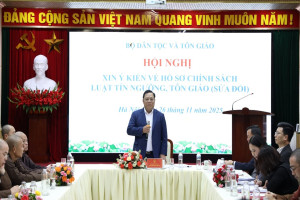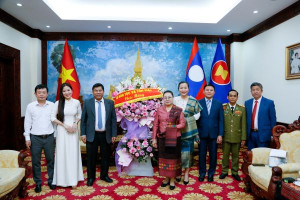
Cau Kho Tam Quan Caodai sect is one of various denominations of Caodaism founded in Vietnam in 1926.
Initially, a group from the central Vietnam province of Binh Dinh while working in Sai Gon (now renamed as Ho Chi Minh city) joint Caodaism at Cau Kho Oratory the only Caodai temple located in the city. After that, some people from this group, including Mr. Nguyễn Hữu Hào and Mr. Nguyễn Hữu Phương, returned to Binh Dinh province to preach the religion to local people. Later, the family of Mr. Phan Boi in Tam Quan town in Binh Dinh province voluntarily dedicated a Buddhist temple on his family’s land for use as the first Cao Dai establishment in the central Vietnam. As the time went by, the number of people from the central Vietnam provinces, including Binh Dinh, Quang Ngai, Phu Yen, Kon Tum, Pleiku and Khanh Hoa converted to Caodaism substantially increased. At a gathering held on February 15, 1937, Caodai followers named the worshipping establishment in Tam Quan town as the central Tam Quan Oratory.
By the year 1939, the religious system under the central Tam Quan Oratory had 19 oratories in provinces and cities of Binh Dinh, Phu Yen, Nha Trang, Thuan An… As the Caodai sect of Cau Kho Tam Quan was fast developing, French colonists and Vietnam feudal authorities decided to ban the religion, arrested some missionaries, confiscated religious materials and prohibited worship of the Divine Eye – the most sacred symbol of Caodaism.
After the Geneva Accord 1954, dignitaries and followers of Caodai Cau Kho Tam Quan sect made a recovery, with more oratories built in localities. In early 1956, the sect’s representatives submitted an application to Binh Dinh province’s authorities for holding a general conference in order to publicly introduce the faith. However, the provincial authorities disapproved the application.
Given this situation, from raised funds, dignitaries and followers of Cau Kho Tam Quan sect in the central region bought a land of 3600m2 also in Tam Quan town of Binh Dinh province, and started to build its Holy See. By 1959, this holy see was completed. From 12-18 of the third lunar month in 1960, Cau Kho Tam Quan Caodai sect organized a solemn ceremony for inauguration of the sect’s Holy See as well as held the first general conference for proclamation of the establishment of the Cau Kho Tam Quan Caodai Church. Typical dignitaries in the establishment of the Church include Nguyễn Văn Phùng, Phan Trường Mạnh, Lê Đại Luân, Nguyễn Phụng Hoàng, Lê Ngọc Cẩn…
The Church’s proclamation well served purposes of publicly announcing the Church founding amongst Caodai sects, established churches and authorities, and establishing the Church’s organizational and personnel structure. The first general conference also issued six operating guidelines based on fundamental principles of Caodaism for serving humanity and leading human society to “Truth – Love – Harmony”.
After the founding proclamation, the Cau Kho Tam Quan Caodai Church faced many difficulties brought by the long war in Vietnam. The 1960-1975 period saw church’s restricted activities, or even inaction at some periods of time.
From the time when Vietnam was unified in 1975 to mid 1990s, the Cau Kho Tam Quan Caodai Church, as well as other Caodai sects, practiced the religion mainly at worshipping facilities, without any considerable religious development.
In 1996, in the light of a new undertaking on Caodaism of the Vietnam Communist Party and State, several dignitaries of the Cau Kho Tam Quan Caodai Church planned to revitalize the Church’s operation by strengthening religious activities and consolidating organizational and personnel structure.
After a preparatory phase, on 3rd of March 2000, dignitaries and followers of the Church from Vietnam South and Central gathered in the Church’s Tam Quan Holy See to attend a general conference, known as the first Popular Congress of the Church. This general conference approved the religious charter and operating guidelines. In accordance with the new religious charter, the Church’s administrative system has central and grassroots levels. The conference also elected 13 members to the two-palace Executive Council, which is the Church central executive body.
The first Popular Congress paved the way for stability and new developments of the Church, such as expanded religious activities, strengthening of local-level organizations and reconstruction of oratories.
Since then, the general Popular Congress has been held on a frequent basis of every five years. Through four congresses held, the Church has strengthened its religious administration from central to grassroots levels and consolidated its religious personnel system. The Church has so far newly built and repaired 20 oratories, including the Tam Quan Holy See, which was reconstructed in late 2003 and inaugurated in early 2007.
Currently the Cau Kho Tam Quan Caodai Church has over 8,500 followers with 26 operative oratories in eight provinces and cities of Vietnam middle region and Central Highlands,
Tri An




